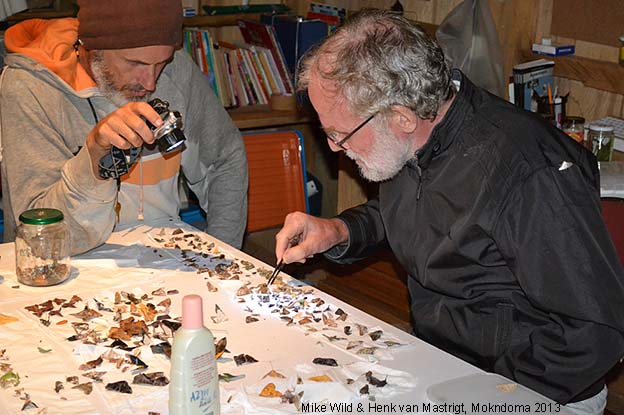
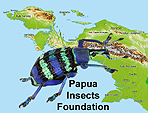


2013
(updated on 13th December 2013)
other issues of our Newsletter:
August 2008 - March 2009 - November 2009 - October 2010 - December 2011
Papua-Insects.nl
The Papua Insects Foundation
The latest news on the Papua Insects Foundation, its website and other relevant items concerning the entomology study in New Guinea
With this newsletter we want to inform you about the latest developments, news and changes in the website and activities of the Papua Insects Foundation and other interesting entomological news of New Guinea. If you have any questions or comments on this, please contact us.
New! At 16th December 2013 will be released: the third field guide on butterflies of Papua: the islands in the Cenderawasih Bay (Teluk Cenderawasih) by Henk van Mastrigt & Evie Lilly Warikar
Henk van Mastrigt & Evie Lilly Warikar, 2013. Buku Panduan Lapangan Kupu-kupu untuk Wilaya Pulau-pulau Teluk Cenderawasih, terfokus pada Numfor, Supiori, Biak dan Yapen (the butterflies on the Islands in the Cenderawasih Bay (former Geelvink Bay), especially the islands Numfor, Supiori, Biak and Japen).
On Monday December 16th, 2013 a new field guide on butterflies will be launched by Henk van Mastrigt and Evie L. Warikar.
The book is in Bahasa Indonesia and consists of nearly 200 pages, including 84 colour plates with 1171 colour pictures.Price including registered airmail:
SUGAPA-subscribers: € 17.50
Others: € 27.50This field guide can be ordered at:
entopapua@gmail.compayments should be addressed to ING-Bank
Account number: 0184194 (Euro currency)
HJG VAN MASTRIGT, Maastricht, The Netherlands
BIC: INGBNL2A
IBAN: NL07INGB0000184194Asian customers should address their payment to Bank BRI in Jayapura, Indonesia
Account number: 2141-01-005891-50-7 (IDR)
SUGAGA KEP QQ VAN MASTRIGT HENRICUS
Swift code: BRINIJA
New! A field guide to the damselflies of New Guinea
V.J. Kalkman & A.G. Orr, 2013. Field Guide to the damselflies of New Guinea.
pp. 3-128. Available for € 15,- For details see: http://www.brachytron.nl/Brachytron/Brachytron16supinhoud.htmlWith this book in hand the reader can identify all genera and most species of damselflies occurring
in New Guinea. It will doubtless stimulate people to explore their local streams and standing
waters of New Guinea and to appreciate the wonderful diversity of damselflies and dragonflies
to be found there. Over 500 copies are being donated to universities throughout New
Guinea. As well as introducing students and researchers to the beauty of damselflies, the guide
provides a basis to study them and use them in biodiversity studies supporting the conservation
of freshwater habitats.The guide contains nearly 300 colour drawings and over 250 line drawings by Albert Orr and
twenty-two colour photographs taken in the field by Stephen Richards. Many genera and most
species included have never been depicted in colour before.Vincent Kalkman has had an interest in the damselflies and dragonflies of New Guinea since
2005. In 2006 and 2008 he conducted fieldwork with the Kelompok Entomologi Papua in the
Indonesian part of the island and in 2009 he joined the expedition by Conservation International
to Muller Range in Papua New Guinea.Albert Orr’s interest in the insect fauna of New Guinea dates back to undergraduate days when
he made two lengthy excursions in 1971 and 1973/4, collecting butterflies and dragonflies. He
has authored and illustrated several identification guides to Asian dragonflies and damselflies
(2003, 2005 and 2007), and the butterflies of Australia (2010).
Text: Vincent Kalkman (Netherlands) & Albert Orr (Australia)
Illustrations: Albert Orr (Australia)
Translation to Bahasa Indonesia: Henk van Mastrigt (Papua, Indonesia) & Evie Warikar (Papua,
Indonesia)
Photographs: Stephen Richards (Australia)
13 new watermites discovered during our last expedition
Harry Smit, a world specialist on watermites (Acari), joined our last survey in the Birdshead Peninsula (Vogelkop) in 2011. During this survey he discovered 33 species of which 13 new to science which are now published in "New records of water mites mainly from Vogelkop, New Guinea (Acari: Hydrachnidia), with the description of one new genus and thirteen new species" in Zootaxa 3716 (2): 207–235. The abstract follows below.
Abstract - New records are given of water mites from Vogelkop, New Guinea. A total of 33 species is recorded, including the descriptions of a representative of a new genus, i.e. Dropursides aberratus, and of twelve further species new to science, i.e. Hydrobaumia purpurea, Oxus manokwariensis, Limnesia multiscutata, Limnesia vogelkop, Australiobates elongatus, Unionicola novaeguineae, Neumania silvestris, Recifella fluviatilis, Koenikea sentaniensis, Albia ilikensis, Albia papuaensis and Axonopsella bisetosa. The female of Albia wauensis Wiles and the male of Axonopsella ovalis Wiles are described for the first time.
Exploration of an unknown area in the Snow Mountains
From 15th to 23rd January 2013, Henk van Mastrigt visited the Wild family at their new home in Mokndoma, Snow Mountains. Mokndoma appears to be a very interesting place for new and rare species of insects.
In 2011 Henk van Mastrigt met the Wild Family (Mike and Libby and the children Morgan, Hudson, Kian and Ascher) at the KSP in Jayapura. The children were enthusiastic collectors of butterflies and some of their specimens and pictures were identified by Henk. At that time the family was living at Kidudumo (E 137°46.775' - S 3°39.712') at 1,600 m in the Central Mountain range, close to the Lumo airstrip, slightly north between Sinak and Mulia. During that first meeting, some records caught the first author’s attention: Helcyra chionippe C. Felder, 1860 (the first record for Papua seen by Henk), some interesting lycaenids including various Hypochrysops and Candalides spp, an aberration or variety of Hyantis hodeva and two specimens of Delias sinak.
From 15th to 23rd January 2013, Henk visited the Wild family at their new home in Mokndoma (E 137°46.500' - S 3°38,649') at 2,180 m, not far from River Nggoduk at Wigoduk (E 137°46.963' - S 3°38,242') at 1,860 m. During that week, collecting was carried out during the daytime (10-13 hours) and at night with the members of the family.
Besides that Henk used his time to teach the childern in catching, conserving and setting insects. The high humidity at Mokndoma will make it hard to dry and conserve specimens there, which was already proved by some specimens stored for over a year on this high altitude.
Henk left with over 2,000 specimens, and surely these includes more than one species new to science. The results of collecting in February and March 2013 (already sent to Henk in Jayapura) confirm that Mokndoma is a very interesting place for new and rare species, collected at day and at night.
At least five new species to science are recognized now, and Henk ensures that more will come up. More information on these and coming results will be published in KEP’s magazine SUGAPA (Voice of Papua Insects).
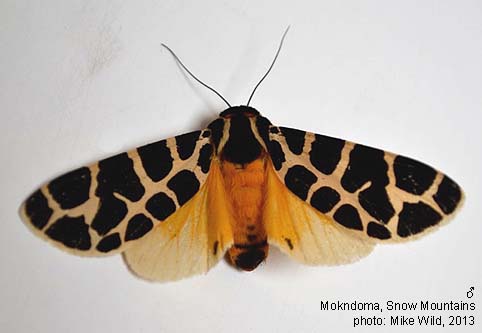
The rare Spilosoma hampsoni Joicey & Talbot, 1916 (Erebidae, Arctiinae)
Papuan phonebook helps scientists describe 101 new beetle species
More than 100 new species of the beetle genus Trigonopterus have been described from the wilderness of New Guinea. The research introduces an innovative approach for rapidly collecting biodiversity data using DNA analysis to beat the fast rates of extinction and disappearance of rainforests. Many of the species were named after local Papuan families found in the yellow pages and can be viewed by everyone in the open access journal Zookeys.
Tropical rainforests are known for their high biodiversity of countless species, many of them unknown and not named by scientists yet. A large proportion of this undiscovered life on earth is formed by insects, especially beetles.
German researchers Alexander Riedel (Natural History Museum Karlsruhe) and Michael Balke (Zoological State Collection Munich), know this well, being experts for faunas of remote tropical countries such as the wilderness of New Guinea. Now they came across a special case, the weevil genus Trigonopterus which is truly “hyperdiverse”. Hundreds of distinct species roam the jungles of this tropical island and most of them have never been recorded by scientists.
To describe this huge diversity using traditional approaches would take more than a lifetime, but there is no time to waste! Forests disappear for the sake of ever expanding palm oil plantations, and good arguments are needed in the battle for the conservation of each hectare of primary forest.
“This called for a new approach”, said Dr Riedel. “A portion of each weevil species’ DNA was sequenced, which helped to sort out and diagnose species efficiently. Besides, we have taken high-resolution photographs of each weevil which will be uploaded to Species ID website, along with a short scientific description. More than 100 species were brought to the light of science and public attention this way right now – about five times faster than possible with traditional techniques!” added Dr Riedel.
Another problem was tackled with an equally innovative idea: To find suitable names, Papua New Guinea´s phonebook was used as a helpful resource. Many species were named for Papuan families found in the yellow pages, for example Trigonopterus moreaorum which is based on the popular name “Morea”. Some of them may not even guess of their honor - a weevil species with their own name in the backyard!
The new species and the general idea of how to get biodiversity better known before it becomes extinct are described in the journals ZooKeys and Frontiers in Zoology, both of them open access under the terms of a Creative Commons Attribution License. As such, the research is open to anyone with internet access for free – in fact, the Papuan people who donated their names may learn about it that way.
Original Sources:
Riedel A, Sagata K, Surbakti S, Tänzler R & Balke M (2013). One hundred and one new species of Trigonopterus weevils from New Guinea. Zookeys 280: 1–150. doi: 10.3897/zookeys.280.3906Alexander Riedel, Katayo Sagata, Yayuk R. Suhardjono, Rene Tänzler and Michael Balke: Integrative taxonomy on the fast track - towards more sustainability in biodiversity research. Frontiers in Zoology (2013), 10:15. DOI: 10.1186/1742-9994-10-15
A study of Swallowtail moths (Uraniidae) - Siep and Jannie Sinnema
From February 12 to 15 2013 Siep and Jannie Sinnema visited the Natural History Museum (BMNH) in London to study the Uraniidae collection of the museum. Mr. Martin Honey, curator of the Lepidoptera collection, was very kind in helping us to find our way in the huge collection in the “Cocoon”, the Darwin Centre of the museum. In three days we were able to make pictures of the content of more than 130 drawers with Cyphura, Urapteroides, Acropteris, Micronia, Stesichora, Strophidia and Decetia. Important for us was to find the types of the species that are in the collection of the BMNH. It resulted in more than 700 pictures.
It was very interesting to meet Dr. Jeremy Holloway, author of The Moths of Borneo, and Mr. David Lees (interested in the butterflies and moths of Papua) during our visit.
With the information of the types and other photographed specimens in the BMNH we could identify the Uraniidae of the collection of Henk van Mastrigt in Jayapura (KSP) which we have photographed during our stay in Jayapura in 2011. This way almost all the Uraniidae specimens could be identified in KSP and the same we did with the specimens we collected ourselves during our expedition in Papua in 2011.
In the collection of BMNH, KSP and the Uraniidae we collected in 2011, we found at least four species that seem to be new to science. Further research will be necessary to check this.
The next step will be to identify the Uraniidae in the collection of the Naturalis Biodiversity Center (RMNH) in Leiden.
Meanwhile we are also contributing to the website of the Papua Insect Foundation (Papua-insects.nl) to complete the pages of the Uraniidae. We hope to establish this in the next months.
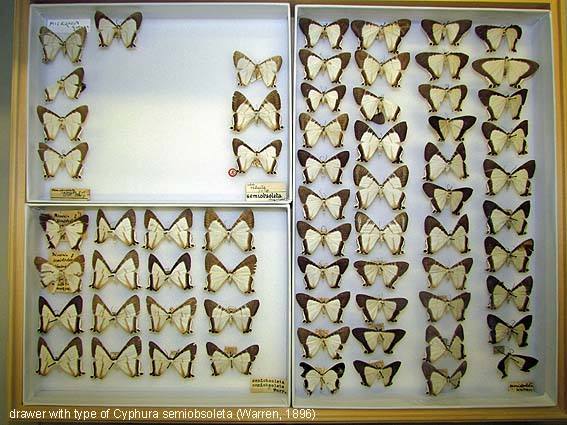
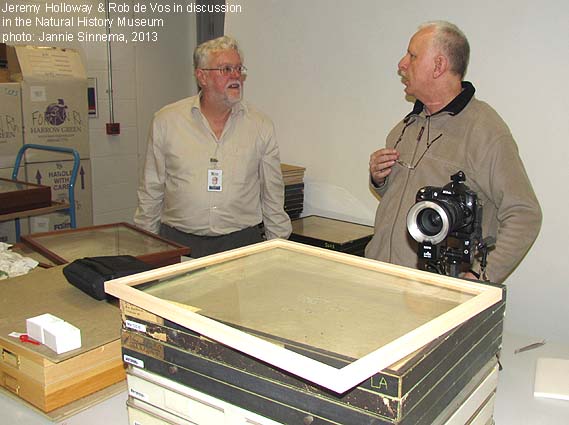
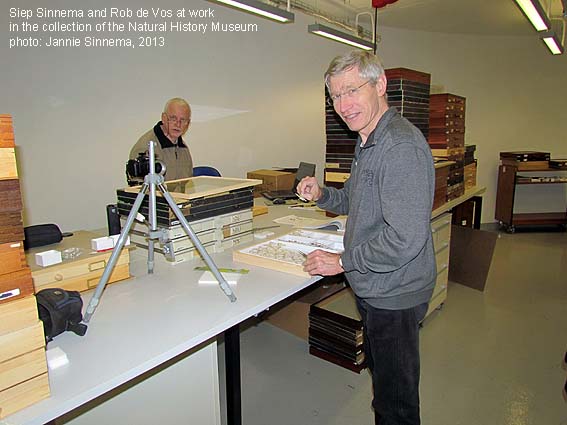
Volume 8(2) (October - December 2013) of SUGAPA is released
SUGAPA is a continuation of the newsletter "SUGAPA" of the Kelompok Entomologi Papua (KEP) which started in July 2006 and since then published 8 issues on the activities of the members of KEP, a group of enthousiast Papuan biology students and teachers of the Cenderawasih University (UNCEN), with Henk van Mastrigt as guide and teacher. Initially the language in the newsletter was Bahasa Indonesia, which was a problem for most interested scientist. The Papua Insects Foundation therefore presented English translated abstracts on the website.
SUGAPA is sponsored by the Van Tienhoven Foundation in The Netherlands. For more information about this foundation click on the logo at the right.
The magazine SUGAPA focusses on international scientists and deal with subjects on Papuan insects. The text will be mostly in English (about 25 % will be in Bahasa Indonesia). More information or subscription
The editors of SUGAPA appeal for entomologists to contribute in their journal, so if you have manuscripts (almost) ready on Papuan insects and want to publish in SUGAPA, please contact the editorial board of SUGAPA.
We like to emphasize that SUGAPA is a registered journal (ISSN 1978-9807) and independently founded by KEP, but it is obvious that the Papua Insects Foundation fully supports this initiative with what we can.
The grow of subscriptions to SUGAPA is less than we expected but we hope that with good advertisement and "mouth to mouth" recommendation the subscriptions will grow to the necessary minimum to cover the finances of the magazine. The most important aim of this magazine is not just making it possible to publish in it quite easy, but to develope a magazine in which most entomologists will publish their information on Papuan insects and to be available to teachers and students in Papua and further.
For the contents of this and previous issues see the abstracts of SUGAPA
STILL AVAILABLE ! A field guide to the butterflies of the Birdshead Peninsula
"Kupu-kupu, untuk Wilayah Kepala Burung Termasuk Pulau-pulau Provinsi Papua Barat" - by the team of Kelompok Entomologi Papua (KEP, "Workgroup Papua Insects")For more information click here
This field guide is sponsored by The World Wildlife Fund and the Dutch "Nationale Postcode Loterij"
News on the website - Rob de Vos
New pictogram buttons
The rather outdated and sometimes confusing blue buttons in this website are gradually replaced by the above depicted pictogram buttons which should make surfing and navigating through the website much easier. The pictograms should speak for themselves which function they have and if not, the text will do. Please let us know if you agree that these buttons are much easier in use. Note that not all pages in the website will be modified at once, but the old buttons still are functioning.
Thumbnail pages
As usual new thumbnail galleries have been added to the website and more are yet to come. Renovations and corrections in the website are part of a daily practice to keep the website up to date and are ongoing. Here follows a list of the major novities on the website since last newsletter. Minor changes are numerous and you will understand that we cannot list those.
Checklists
Of the insects pages, in fact the most important part of the website, the following list shows the new or renewed checklists
- Lepidoptera: Lecithoceridae (Kyu-Tek Park) A checklist of the species [November 2012]
- Lepidoptera: Bombycidae (Vadim Zolotuhin) A checklist of the species [October 2012]
- Lepidoptera: Eupterotidae (Vadim Zolotuhin) A checklist of the species [October 2012]
- Lepidoptera: Lasiocampidae (Vadim Zolotuhin) A checklist of the species [October 2012]
- Lepidoptera: Pieridae (Henk van Mastrigt) Most of the species pages ready [February 2012]
- Lepidoptera: Riodinidae (Stefan Schröder) Separated from the Lycaenidae, according to recent systematic views [April 2012]
- Lepidoptera: Drepanidae (Drepaninae) (Peter MacKey) Species pages and thumbnail gallery are ready [September 2012]
- Lepidoptera: Uraniidae (Siep & Jannie Sinnema) A checklist of the species [March 2013]
- Lepidoptera: Noctuidae (Pantheinae) (Rob de Vos) A revised checklist of the species with species pages [May 2012]
- Lepidoptera: Noctuidae (Dyopsinae) (Rob de Vos) A revised checklist of the species with species pages [May 2012]
- Lepidoptera: Euteliidae (Euteliinae & Stictopterinae) (Rob de Vos) A checklist of the species [May 2013]
Lycaenidae and Notodontidae species pages are in preparation
We hope that contributors who promissed us a checklist of their insect group will soon send it to us for preparing. If you have additional information or a new family to add to the website please contact the webmaster.
Have a look at the following interesting new History pages:
Available thumbnails at this moment are:
- Orthoptera: Tetrigidae
- Odonata: Anisoptera
- Odonata: Zygoptera
- Hemiptera: Auchenorrhyncha (Cicadidae, Tibicinidae)
- Hemiptera: Auchenorrhyncha (Fulgoridae, Flatidae)
- Hemiptera: Heteroptera (Pyrrhocoridae, Miridae, Tessaratomidae)
- Hemiptera: Heteroptera (all families, unidentified specimens)
- Coleoptera: Anthicidae
- Coleoptera: Carabidae
- Coleoptera: Dytiscidae
- Coleoptera: Cerambycidae (Lamiinae)
- Coleoptera: Cerambycidae (Prioninae)
- Coleoptera: Cerambycidae (Cerambycinae)
- Coleoptera: Cicindelidae
- Coleoptera: Curculionoidea, Brentidae
- Coleoptera: Curculionoidea, Curculionidae
- Coleoptera: Curculionoidea, Attelabidae
- Coleoptera: Endomychidae
- Coleoptera: Scarabaeidae (Cetoniinae)
- Coleoptera: Lucanidae
- Lepidoptera: Hepialidae
- Lepidoptera: Cossidae
- Lepidoptera: Psychidae
- Lepidoptera: Alucitidae
- Lepidoptera: Pterophoridae
- Lepidoptera: Tortricidae
- Lepidoptera: Sphingidae
- Lepidoptera: Papilionidae [under construction]
- Lepidoptera: Pieridae [under construction]
- Lepidoptera: Drepanidae (Thyatirinae)
- Lepidoptera: Drepanidae (Drepaninae)
- Lepidoptera: Erebidae (Aganainae)
- Lepidoptera: Erebidae (Erebinae) [under construction]
- Lepidoptera: Erebidae (Arctiinae, Lithosiini) [under construction]
- Lepidoptera: Erebidae (Arctiinae, Arctiini)
- Lepidoptera: Erebidae (Arctiinae, Syntomini)
- Lepidoptera: Noctuidae (Agaristinae)
- Lepidoptera: Noctuidae (Plusiinae)
- Lepidoptera: Noctuidae (Pantheinae)
- Lepidoptera: Noctuidae (Dyopsinae)
- Lepidoptera: Nolidae (Nolinae)
- Lepidoptera: Nolidae (Chloephorinae)
- Lepidoptera: Nolidae (Collomeninae)
- Lepidoptera: Nolidae (Risobinae)
- Lepidoptera: Nolidae (Westermanniinae)
Appeal for more information on other insect groups and items for the next newsletter
At the moment we have contact with more than 50 entomologists in the world who more or less contribute to our website or promissed to do so. We would appreciate your cooperation to provide us of information and checklists of your specialism concerning New Guinea in general or Papua Indonesia in particular. If you know of some other specialists who potentially could be interested to contribute to our website, please let him/her know of us or inform us.
If you have interesting news or information to put in the next newsletter you are very welcome to. Please contact the webmaster to deliver and discuss your contribution.
We rely and depend on you!